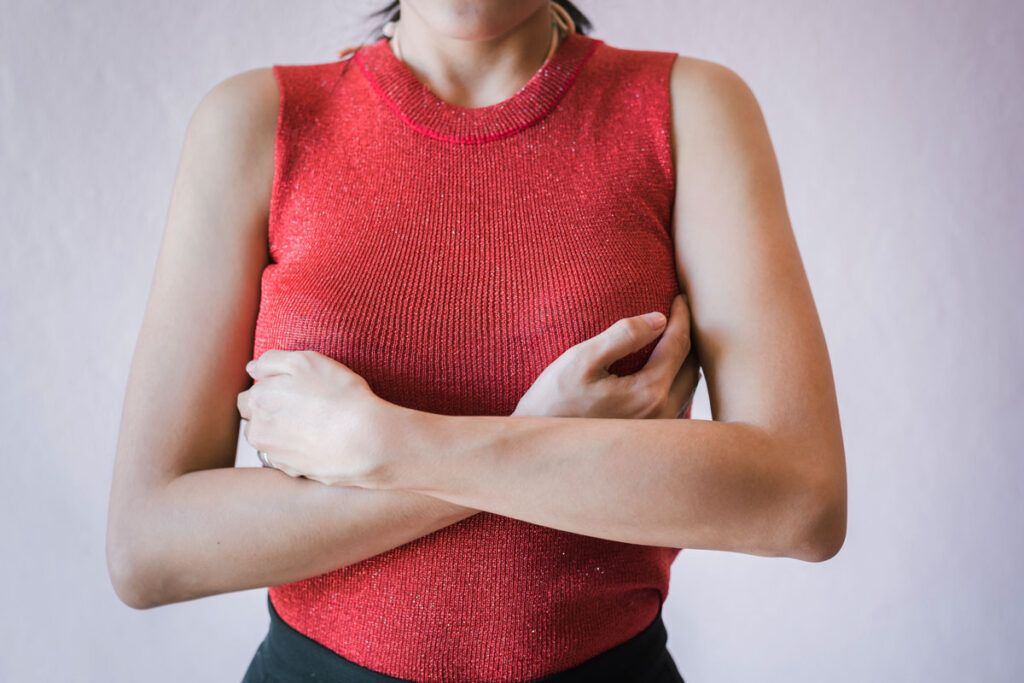Eczema is a type of skin condition that causes symptoms of itchy, dry, and discolored skin patches.
According to the National Eczema Association (NEA), more than 16.5 million adults in the United States experience atopic dermatitis, the most common type of eczema.
Breast eczema is when you experience symptoms of eczema around the breasts. The exact cause is unknown, but you may be more at risk if a family member has a history of eczema or hay fever.
Read on to learn more about breast eczema, what can trigger symptoms, and the different ways to manage them.
Causes

The underlying cause of eczema is still unknown, but research suggests that it may be genetic, and you might be more likely to develop it if you have asthma or hay fever. For example, one 2020 study found 150 shared risk genes between these three conditions.
There is no way to prevent eczema flare-ups completely. But learning some potential triggers can help you minimize the frequency of flare-ups.
Here are some known triggers.
- Temperature: Moving from one temperature to another, such as from a warm home to the cold outdoors, or changing seasons, can worsen symptoms. Central heating can also have the same effect.
- Fabrics: Certain materials, such as wool, may also irritate the skin, so wearing thin clothing may help avoid flare-ups. This can also help with symptoms during a flare-up.
- Cosmetics or toiletries: Certain substances that contain perfumes, like some moisturizers, can trigger eczema. Selecting non-perfumed cosmetics can help prevent flare-ups, including shaving cream and aftershave.
- Food and diet: Touching certain uncooked foods, like garlic, peppers, chilies, and onions, can irritate eczema. Still, there is no clinical evidence that what you consume can make eczema worse, although food allergies can also be present in people with eczema.
Symptoms
Symptoms may vary from person to person, as well as how severe the symptoms feel. Symptoms that most people may experience include:
- itchy, painful skin
- red patches of skin on lighter-skinned people
- brown, gray, or purple patches of skin on darker-skinned people
- scaly skin
- scratch marks
- dry skin
- bleeding
If you experience breast eczema, you will likely develop these symptoms on or around the breast area. The area of the breast most often affected by eczema is the areolae. This is the region around the nipples with darker skin pigmentation.
Medical treatments
While there is no cure for atopic dermatitis, there are medical treatments that a healthcare professional may prescribe to help manage your symptoms.
A healthcare professional may recommend prescription medications as the first line of treatment, or if your condition worsens.
These are some medications they may recommend.
- Topical steroids: These are available in different forms, most commonly ointments and creams. The strength of these depends on the type of skin being treated. With breast eczema, the skin is thinner, so a healthcare professional may recommend lower strength steroids. These include hydrocortisone and triamcinolone.
- Non-steroid topical treatments: These are other medications applied to the skin to help treat eczema. Crisaborole ointment can be used to treat patients over the age of 3 months, and ruxolitinib cream can be used on people ages 12 years and above.
- Topical calcineurin inhibitors: These medications work by blocking calcineurin, a protein responsible for producing inflammatory cytokines that signal the processes responsible for eczema. Some examples of these include pimecrolimus and tacrolimus.
- Oral steroids: Rarely, a healthcare professional may recommend a short course of oral steroids for severe flare-ups. This is not usually done for children, no matter how severe the symptoms are. An example of an oral steroid is prednisone.
- Antibiotics: Eczema can leave the skin open to infection, so some antibiotics may be used if a healthcare professional determines you need them. The duration of treatments will vary, but they do not typically exceed 14 days.
- Phototherapy: Short sessions of phototherapy, where a professional delivers UVA/B radiation, can help reduce itching and inflammation. This may cause dryness and redness or even mild sunburn. Still, it is highly effective.
If you need help covering the cost of medications, the free Optum Perks Discount Card could help you save up to 80% on prescription drugs. Follow the links on drug names for savings on that medication, or search for a specific drug here.
